How To Use a VPN on Samsung Smart TV: Easy 2025 Setup
I have a love-hate relationship with my Samsung Smart TV. The screen is beautiful, apps open really fast, and it feels like the centerpiece of my living room. But I really hate the limited streaming libraries and the Tizen OS. And I know I’m not the only one — with over 67 million households using Samsung Smart TVs in the US1, these headaches are all too familiar.
Can you install a VPN on a Samsung Smart TV? Not directly. I tried doing it myself, and there’s absolutely no way to get it to work on the device using the Samsung App Store. The only alternatives I found are installing a VPN on your router, using a Smart DNS, installing it on a TV stick, or sharing a VPN connection from a laptop to the TV.
When I first tried these options, I couldn’t believe the difference; everything on my QLED screen finally felt complete, and all the streaming apps were working just the way I’d hoped. I’ve prepared guides on how to use a VPN on Samsung TV, so you can choose the one that works best for your setup.
Best Ways to Use a VPN on Samsung Smart TVs
Using a VPN on a Samsung Smart TV is not a one-size-fits-all setup. The right method depends on what you care about most. Do you want the simplest way to stream? Are you looking for whole-home coverage? Or do you just want a quick workaround without new hardware? Before diving into the step-by-step guides, here’s a quick snapshot of each method:
| Method | Pros | Cons |
| Install the VPN on a router | ✅ Full-home coverage for every device ✅ Strong security with full encryption |
❌ Setup can be tricky ❌ Requires a VPN-compatible router |
| Share a VPN connection via hotspot | ✅ Fastest to set up ✅ No extra hardware needed |
❌ Dependent on the laptop/PC being on ❌ Battery drain on portable devices |
| Share a VPN network via Ethernet | ✅ Stable wired connection ✅ Avoids WiFi dropouts |
❌ Less flexible, needs a cable ❌ Setup takes longer than a WiFi hotspot |
| Install a VPN on a TV stick | ✅ Native VPN apps available ✅ Easy to switch servers directly |
❌ Extra hardware required ❌ Adds another remote and interface |
| Use a VPN’s Smart DNS | ✅ Very quick setup ✅ Often the fastest streaming speeds |
❌ No encryption or privacy ❌ Limited to certain regions |
How To Install a VPN on a Samsung Smart TV — 5 Easy Methods
There’s no single “install and done” method for using a VPN on a Samsung Smart TV. Trust me, I’ve tried everything, and these are the only 5 ways that actually work. Some are quick fixes, and some are better long-term solutions.
How To Use a VPN on a Samsung TV via a Router
This is the most reliable way of using a VPN on a Samsung Smart TV. Once the VPN is running on your router, all your devices (including the TV) are secured.
The guide below shows you how to manually install a VPN on a router, but some routers also come with VPNs pre-installed. The steps are more or less the same for all VPNs, but you can also find specific instructions for your vendor on its website. For simplicity purposes, we’ll use ExpressVPN with its custom router firmware on a TP-Link router as an example in the guide below.
1. Check That Your Router Is VPN Compatible
See if your router supports VPN firmware like DD-WRT, OpenWrt, or Tomato. Popular brands like Asus, Netgear, Linksys, and TP-Link usually do. If not, you’ll need to get a VPN-ready router.
2. Get a VPN
Sign up for a fast and secure VPN that works with routers (ExpressVPN, CyberGhost, NordVPN are just a few examples) and log in to your account dashboard.
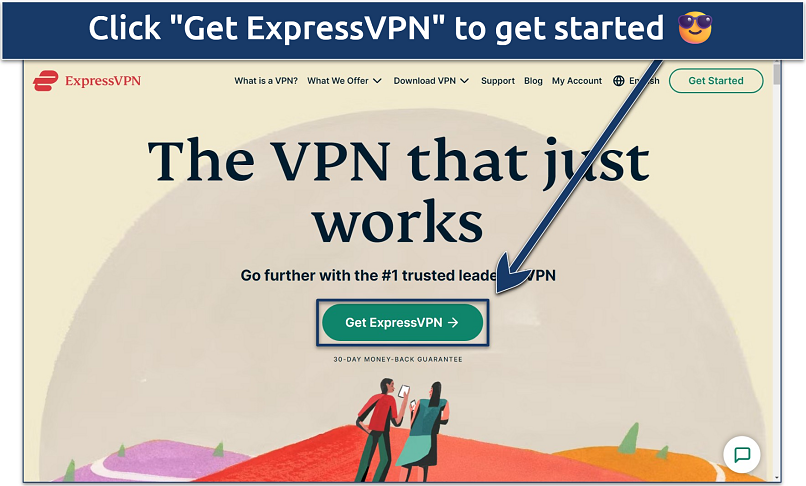 The process is similar for other VPNs on their websites
The process is similar for other VPNs on their websites
3. Find the Configuration Settings for Your Router
Search for something like “Set up your devices” and download the router setup files from the manual configuration section.
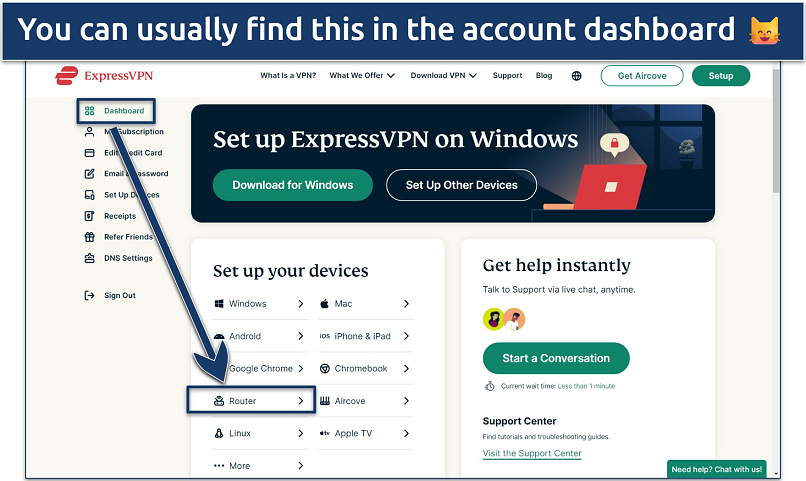 Most premium VPNs will display similar options
Most premium VPNs will display similar options
4. Manually Configure the VPN Connection
Fill in all your details to complete the setup. This can be anything from choosing the protocol to choosing the server location. Depending on the VPN, you’ll either get a unique username and password for your router, or you’ll be able to use your account details. Either way, keep these handy for later.
Once you’re done, download the.ovpn file, which you’ll use to import the settings to your router.
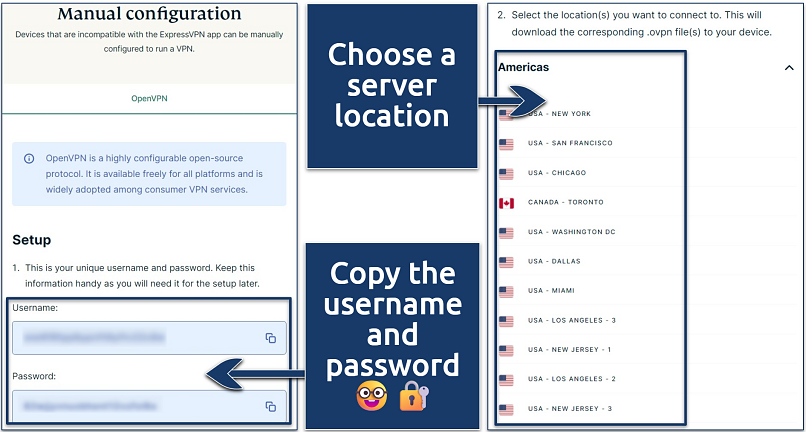 Some VPNs let you name and save different configurations for different devices
Some VPNs let you name and save different configurations for different devices
5. Log in to Your Router
Enter your router’s IP and go to the admin panel. By default, you’ll have to enter either 192.168.0.1 or 192.168.1.1 in the URL bar of your browser. If you’ve never changed these, the factory settings will be “admin” for both the username and the password fields.
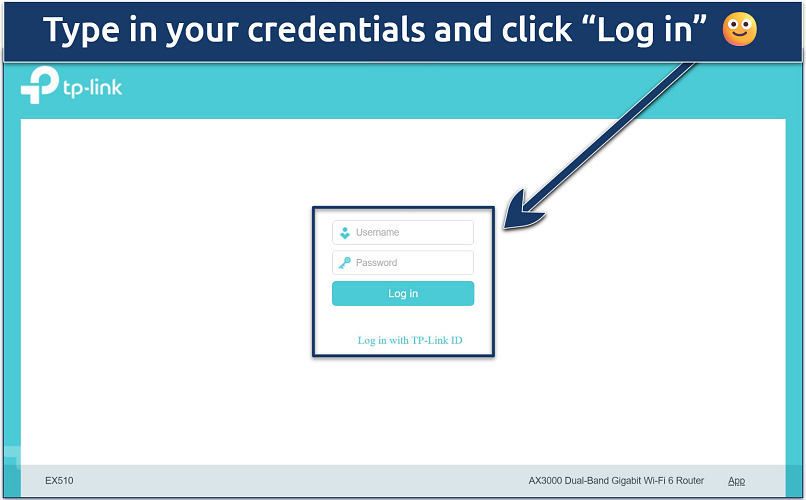 If you forgot your details, you need to reset your router or contact your ISP
If you forgot your details, you need to reset your router or contact your ISP
6. Find Your Router's VPN Settings
In the dashboard, look for your router’s VPN settings. This can be listed under Advanced, VPN, or Security, depending on your router.
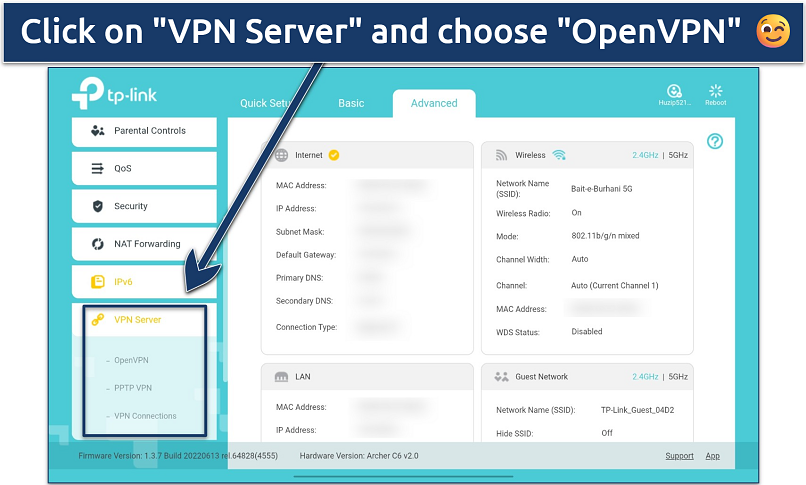 If VPN settings don’t appear, you’ll need to change your router
If VPN settings don’t appear, you’ll need to change your router
7. Configure a Router VPN
Enter your VPN details that we got earlier and upload the.ovpn file. Then, hit the Save or Activate button to connect.
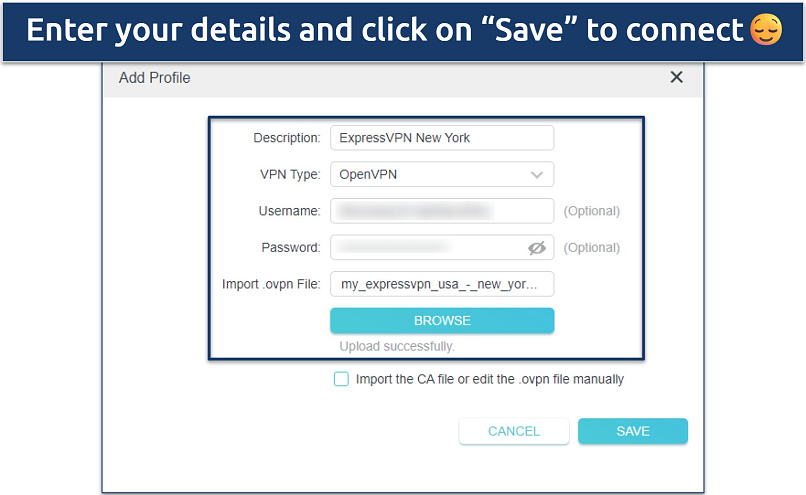 Make sure to import the.ovpn file to actually connect to the server
Make sure to import the.ovpn file to actually connect to the server
8. Start Using a VPN on Samsung TV
Reconnect your Samsung TV to the WiFi connection and open your streaming apps. The VPN now covers your entire network.
Quick Comparison Table: Best VPNs for Samsung Smart TVs
Not every VPN works perfectly with Samsung Smart TVs, so I tested a bunch to find the best ones. Here’s a quick rundown of my top recommendations.
How To Set up a VPN on a Samsung TV via Connection Sharing
This method is quite handy if you don’t want to deal with the complexities of setting up a VPN on your router. Basically, you connect to a VPN on your device and then share the connection through a mobile hotspot. This works on Android phones, iOS devices, and macOS laptops and desktops.
1. Download and Install a VPN
As always, install a high-quality VPN on your device. I’ll use my Windows laptop and install the VPN on it.
2. In the VPN App, Choose a Server
Pick a server close to your location for the best streaming experience. Nearby servers reduce the distance your data travels, which means faster speeds and excellent streaming quality.
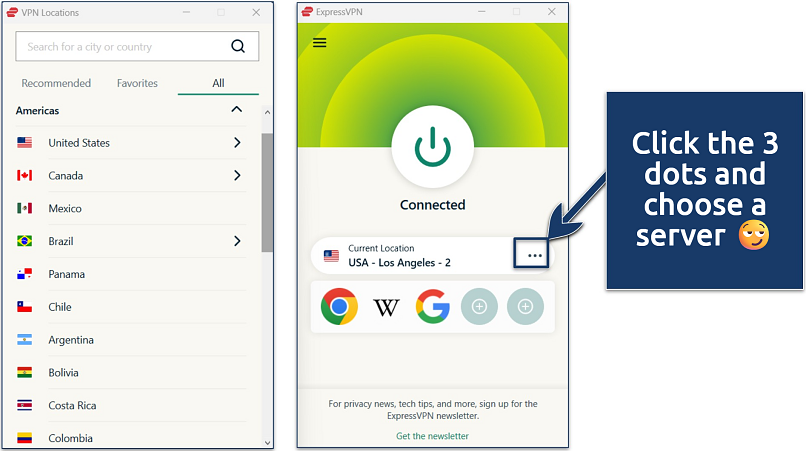 You can save servers to your 'Favorites' for faster access anytime
You can save servers to your 'Favorites' for faster access anytime
3. Share the Connection From Your Device
Go to settings and look for Network & Internet options. This can vary depending on the device you’re using, but you can also just search for Mobile Hotspot settings. Just click on Mobile Hotspot and activate the connection.
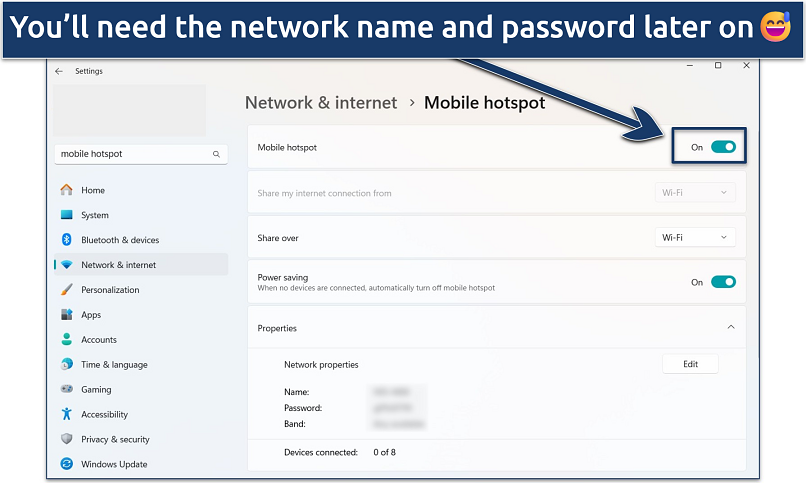 You can also press Windows + S, then search for "Mobile Hotspot"
You can also press Windows + S, then search for "Mobile Hotspot"
4. Connect Your Samsung TV to Your Mobile Hotspot
Go to your Samsung TV’s network settings and look for wireless connections. Search for the hotspot connection you just enabled and connect to it.
5. Securely Stream on Samsung TV
Now, launch your streaming service of choice and start watching shows, movies, and more without interruptions — all while keeping hackers and snoops off your Crystal UHD, QLED, Neo QLED, or OLED screen.
How To Use a VPN on a Samsung TV via Ethernet
If you don’t want to rely on WiFi, you can run a wired connection from your PC straight to your Samsung TV. I’ve used this when I don’t want to be limited by my WiFi speeds, and it worked like a charm.
1. Install and Connect a VPN on Your Laptop or PC
Install a trustworthy VPN and choose the server you want. Some VPNs even have desktop apps built for smoother performance. For example, ExpressVPN comes with Lightway Turbo, which boosts speeds on Windows devices by channeling traffic through multiple tunnels.
2. Connect Your Laptop to Your Samsung TV With an Ethernet Cable
Plug one end of the Ethernet cable into the laptop and the other into the TV’s LAN port. Make sure both your TV and your laptop have a working Ethernet port beforehand.
3. Share the VPN Connection From Your Laptop
On Windows, go to Network & Internet settings and look for Mobile Hotspot and Sharing, then enable Ethernet sharing.
4. Switch Your TV to Wired Mode
Go to your TV’s Network settings, click on Network Type, and select Wired.
5. Start Streaming
Your Samsung TV can now access the internet with your computer’s VPN connection for a stable and secure streaming experience.
How To Use a VPN on Samsung TV via a TV Set-Top Box or TV Stick
Finally, this is the easiest option if you prefer using native VPN apps instead of workarounds. I’ve done this with both a Fire TV Stick and an Android TV box, and the setup only took a few minutes.
1. Plug in a Streaming Set-Top Box or TV Stick
Connect it to your Samsung TV’s HDMI port and connect it to WiFi or Ethernet. Platforms like Fire TV Stick, Apple TV, Android TV, or Google TV support VPN apps directly.
2. Download Your VPN App
Go to the app store, install your VPN of choice, and log in. Most VPN apps work for streaming right out of the box, so you can start watching without tweaking any settings.
3. Connect to a Server
You’ll get the best streaming speeds and quality connecting to a server close to your real location. Some VPNs even offer features that can automatically choose the best server for your network.
4. Start Streaming
As the VPN is running on the box, you can access any app securely without extra setup on your Samsung TV and start watching your favorite shows.
How To Use a VPN’s Smart DNS on a Samsung TV
Smart DNS is a feature that many VPNs provide and gives you a VPN-like streaming experience on devices that don’t natively support VPN apps. Keep in mind, though, it typically supports fewer locations compared to VPNs.
It’s the fastest method I’ve tried because it doesn’t encrypt your connection (not ideal in terms of security), but great if you want to stream without losing any speed on a slow connection. If you have a VPN that supports Smart DNS, follow these steps to set up the service on your Samsung smart TV:
1. Download a VPN
Choose a VPN that offers Smart DNS and servers in your preferred locations.
2. Activate Smart DNS
Log in to your VPN dashboard and navigate to the Smart DNS page. Some VPNs require that you register your TV’s IP address (you’ll find it under your TV’s network settings). Once that’s done, you should get two Smart DNS IPs labeled “IP #1” and “IP #2” or “Primary” and “Secondary” IP.
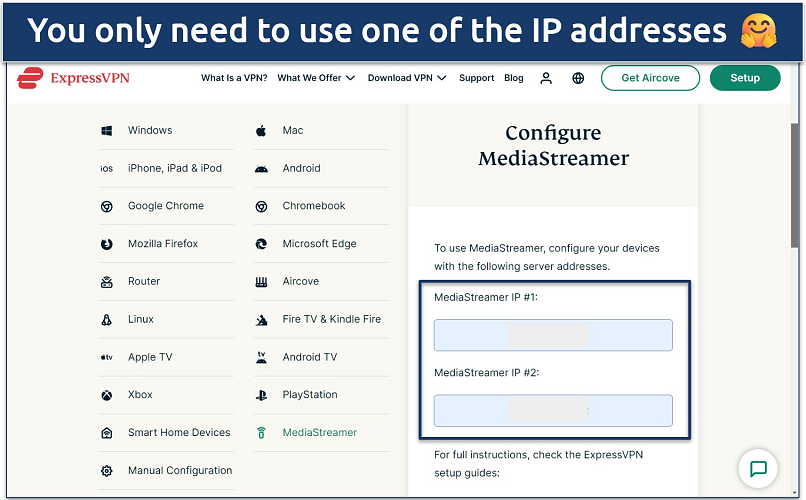 MediaStreamer is ExpressVPN's Smart DNS service for streaming content from the US and UK
MediaStreamer is ExpressVPN's Smart DNS service for streaming content from the US and UK
3. Configure the DNS on Your Samsung TV
Find your Samsung Smart TV’s network settings and look for the DNS option. Click on it, enter the Primary or Secondary Smart DNS IPs we got earlier, and select OK.
4. Connect to a Server
Some VPNs also let you choose the server location in the VPN dashboard. If so, then choose a server nearby for the fastest speeds.
5. Start Streaming on Your Samsung Smart TV
Restart your TV and start watching your favorite shows interruption-free. If you want to change your Smart DNS server, just repeat the steps above.
Our Methodology for Testing Different Ways To Pair a VPN With Samsung Smart TVs
We tested different ways to set up a VPN on Samsung Smart TVs to find out which actually make streaming smoother and/or more secure. That included setting up router VPNs, Smart DNS, and using Ethernet and WiFi hotspots to see how well they performed in real-world conditions on the TV. With each method, we thoroughly evaluated for ease of setup, streaming quality, stability during extended viewing sessions, and how well it kept privacy intact.
From our experience, the best approach is the one that balances ease of use with fast speed and robust protection. Knowing my data and streaming activity are protected when streaming on any device gives me peace of mind. That’s why I recommend being cautious with any method of setting up a VPN on a Samsung TV that doesn’t provide proper protection.
Mistakes To Avoid When Installing a VPN on Your Samsung Smart TV
Even if you follow a step-by-step guide, it’s easy to run into problems if you overlook things. So, here are some of the most common mistakes that we’ve seen and their fixes:
- Expecting to find a native Tizen VPN app in the Samsung App Store. Samsung TVs run on Tizen OS, not Android, so you won’t see proper VPN apps like ExpressVPN or NordVPN. There’s a “VPN TV” app listed in the store, but I couldn’t download or test it. And from what I’ve seen, it’s basically non-existent in practice.
- Trying to install Android apps on a non-Android TV. Don’t waste time sideloading APKs. At best, they won’t install, and at worst, you could brick your TV or void the warranty.
- Relying only on Smart DNS. Smart DNS is great for speed and streaming, but it doesn’t encrypt your network traffic. ISPs can still throttle your connection, and most services only support a few regions (usually the US, UK, and Australia).
- Forgetting to re-register your IP with Smart DNS. If your ISP changes your home IP, Smart DNS will stop working until you register the new one in your VPN dashboard.
- Using an incompatible router. If your router only supports “VPN passthrough,” it won’t work. You’ll need a VPN-ready model or a pre-flashed VPN router.
- Skipping a network refresh on the TV. After setup, restart your TV or reconnect to WiFi. Without this, it may still use old network settings.
- Not asking for help when stuck. Router setups can get tricky. Most top VPNs have 24/7 live chat and deal with these issues every day. Don’t spend hours troubleshooting when support can fix it in minutes.
FAQs


References
- https://nscreenmedia.com/fact-check-samsung-smart-tv-dominance-media-player-slump/
- https://research.csiro.au/ng/wp-content/uploads/sites/106/2016/08/paper-1.pdf/
Your online activity may be visible to the sites you visit
Your IP Address:
216.73.216.172
Your Location:
US, Ohio, Columbus
Your Internet Provider:
Some sites might use these details for advertising, analytics, or tracking your online preferences.
To protect your data from the websites you visit, one of the most effective steps is to hide your IP address, which can reveal your location, identity, and browsing habits. Using a virtual private network (VPN) masks your real IP by routing your internet traffic through a secure server, making it appear as though you're browsing from a different location. A VPN also encrypts your connection, keeping your data safe from surveillance and unauthorized access.



Please, comment on how to improve this article. Your feedback matters!